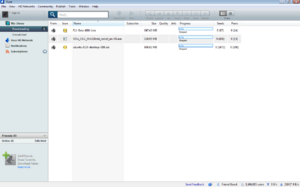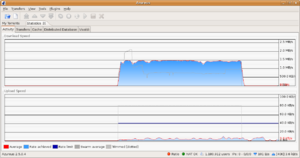Vuze facts for kids
 |
|
| Developer(s) | Azureus Software |
|---|---|
| Initial release | June 2003 |
| Last release | |
| Preview release | 5.7.6.1 Beta 1 (November 2, 2017) |
| Written in | Java |
| Platform | Java (software platform) |
| Size |
|
| Available in | 38 languages |
|
List of languages
English, German, French, Dutch, Portuguese, Spanish, Swedish, Chinese (simplified), Chinese (traditional), Polish, Finnish, Danish, Italian, Russian, Norwegian, Bulgarian, Brazilian-Portuguese, Czech, Lithuanian, Slovenian, Turkish, Catalan, Galician, Greek, Hebrew, Serbian, Serbian (latin), Malay, Japanese, Hungarian, Romanian, Thai, Korean, Slovak, Bosnian, Frisian, Macedonian, Georgian
|
|
| Type | BitTorrent client |
| License | GNU General Public License v2 |
Vuze (which used to be called Azureus) is a special computer program. It helps people share and download files using something called the BitTorrent protocol. Think of it like a system for sharing big files in small pieces.
Vuze is built using a computer language called Java. It uses a core part known as the Azureus Engine. Besides just downloading files, Vuze also lets users watch, share, and publish their own videos. These videos can be in high-quality formats like DVD or HD. You can find this content organized into different channels and categories. These might include TV shows, music videos, movies, and even video games.
Azureus first came out in June 2003. It was created to try out a new software tool called the Standard Widget Toolkit. Over time, it became one of the most popular programs for sharing files. The original Azureus software was free software, meaning people could use and change it freely. However, newer versions of Vuze added some parts that are not free. Users now have to agree to more rules to use these parts.
Contents
How Vuze Works
Sharing Files Between Networks
Vuze has a special feature that helps connect two different computer networks. These are the regular internet, sometimes called the clearnet, and a more private network called I2P. I2P helps users stay anonymous online.
Vuze has a plugin that links to the I2P network. If you add a file to share from I2P, Vuze can share it on both I2P and the regular internet. The same happens if you add a file from the regular internet; it can be shared on both networks. This means files that were only available on I2P can now be found by anyone on the internet. Also, people using I2P can download any file from the internet while keeping their identity private.
As of 2023, another program called BiglyBT also started supporting I2P.
History of Vuze
The Beginning: Azureus
Azureus was first released in June 2003. The name and logo came from the blue poison dart frog, Dendrobates azureus. One of the creators, Tyler Pitchford, liked to use Latin names of these frogs for his projects.
Becoming Vuze
In 2006, some of the original developers formed a company called Azureus Inc., which soon became Vuze, Inc.. They wanted to change the program into a "social" tool. For a while, there were two versions: Vuze and a Vuze-free version of Azureus. The Vuze versions had higher numbers, like 3.0, while the Vuze-free ones continued with 2.5.
Some developers didn't like the idea of changing the program completely. Eventually, Vuze was combined with Azureus. By June 2008, the developers decided to stop using the name Azureus for new releases. They fully changed the name to Vuze with version 3.1. However, the main part of the program, the engine, is still called Azureus.
Changes to the Rules for Use
Before version 2.5.0.4, Azureus was shared under the GNU General Public License (GPL). This license means the software is free to use, share, and change. But starting with version 3, the rules changed during installation.
While the "Azureus Application" was still under the GPL, users also had to agree to rules for the "Vuze Platform." These new rules had limits on how the software could be used. For example, they included a rule that people "under the age of 18" should not use the software. There was some discussion about whether these rules applied to the website or the program itself.
New Ownership
In December 2010, a company called Spigot Inc bought Vuze.
A Pause in Development and a New Path
Around early 2017, the development of Vuze slowed down a lot. There were no new updates or changes for several months. The two main developers eventually left the project. They started working on a new version of the software called BiglyBT. This new program removed some of Vuze's extra features, like video sharing and ads. BiglyBT is a "fork," which means it's a new project that started from the existing Vuze code.
See also
 In Spanish: Vuze para niños
In Spanish: Vuze para niños



